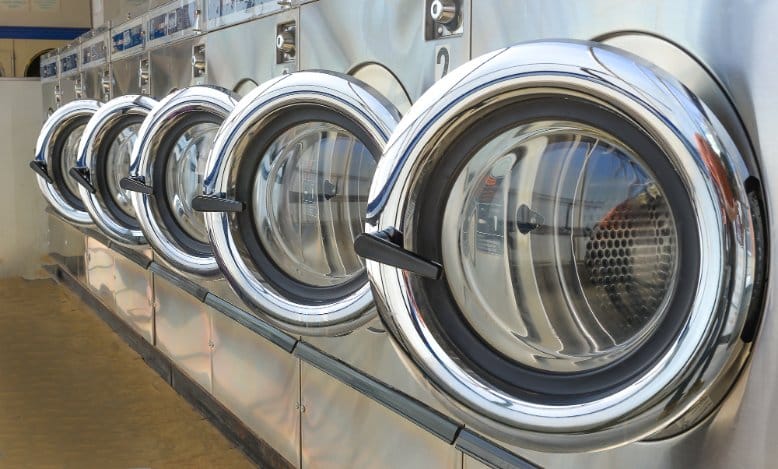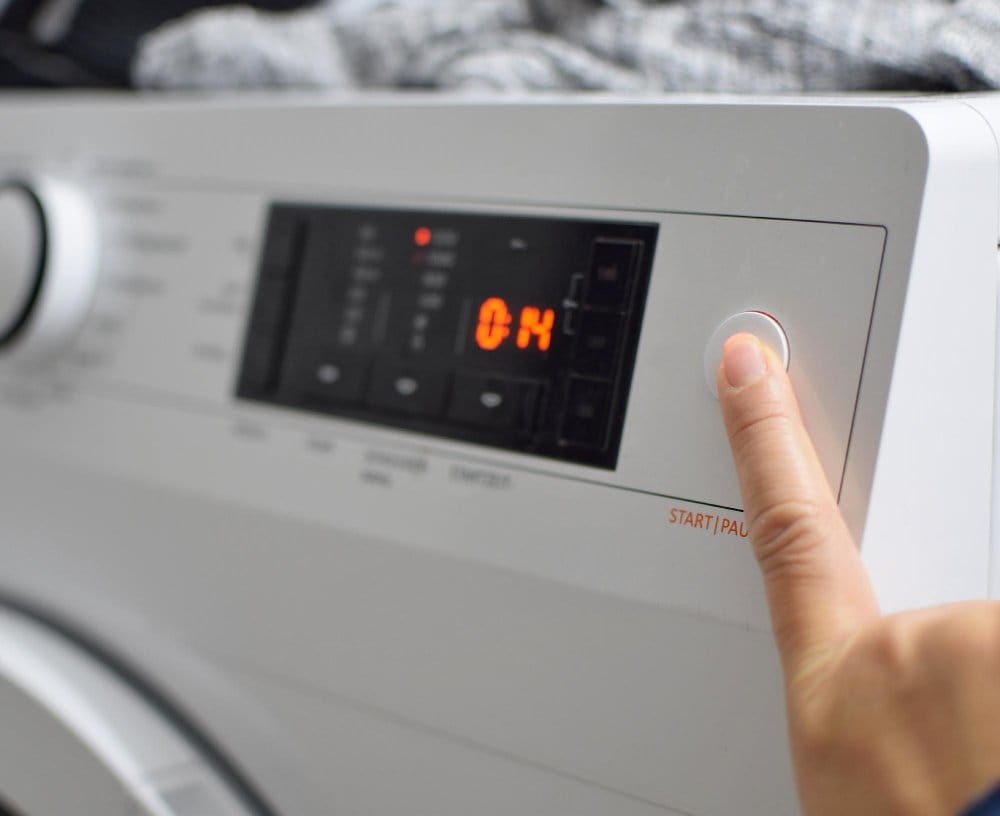Understanding Regional Differences, Types, and Which Dryer Technology is Best for Your Home
Many people wonder whether “dryer” and “tumble dryer” refer to the same appliance when shopping for laundry equipment. A tumble dryer is a type of dryer that uses a spinning drum and hot air to dry clothes, and in most cases, these terms are used interchangeably. However, there are regional differences in terminology and various types of dryers available in the market.
Understanding the differences between dryer types, their features, and installation requirements can help you make an informed decision that fits your home and budget. This comprehensive guide covers everything from basic terminology to advanced smart features and energy efficiency considerations.
Table of Contents
Understanding Dryer Terminology
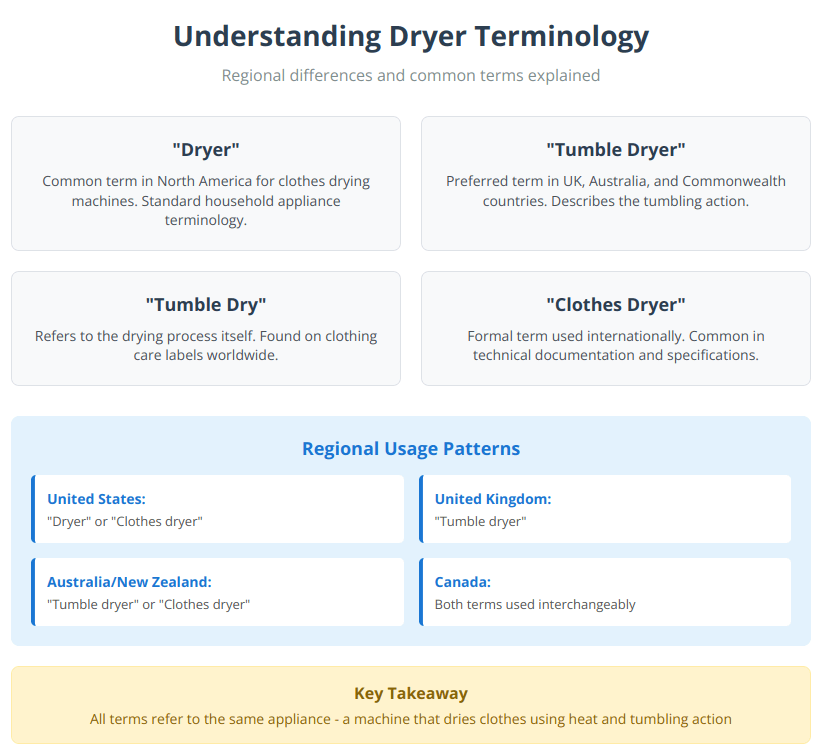
Is a Tumble Dryer the Same as a Dryer?
The terms “dryer” and “tumble dryer” typically refer to the same appliance, but usage varies by region. In the United States, “dryer” is the standard term for household clothes dryers. In the United Kingdom, Australia, and other Commonwealth countries, “tumble dryer” is more commonly used.
Regional Usage:
- United States: “Dryer” or “clothes dryer”
- United Kingdom: “Tumble dryer”
- Australia/New Zealand: “Tumble dryer” or “clothes dryer”
- Canada: Both terms used interchangeably
What is the Difference Between Tumble Dry and Dryer?
“Tumble dry” refers to the drying process itself, while “dryer” refers to the machine. When care labels say “tumble dry,” they mean the item can be dried in a machine that tumbles clothes while applying heat. The tumbling action helps clothes dry evenly and prevents them from clumping together.
How Do I Know If My Dryer Is a Tumble Dryer?
Nearly all modern household dryers are tumble dryers. If your dryer has a rotating drum that spins clothes while hot air circulates, it’s a tumble dryer. The key characteristics include:
- Rotating drum that turns clothes over during drying
- Hot air circulation system
- Various temperature and time settings
- Lint filter to catch fabric fibers
Types of Dryers: A Complete Breakdown
What Are the Three Types of Dryers?
There are three main types of dryers available in the market, each with different methods of moisture removal:
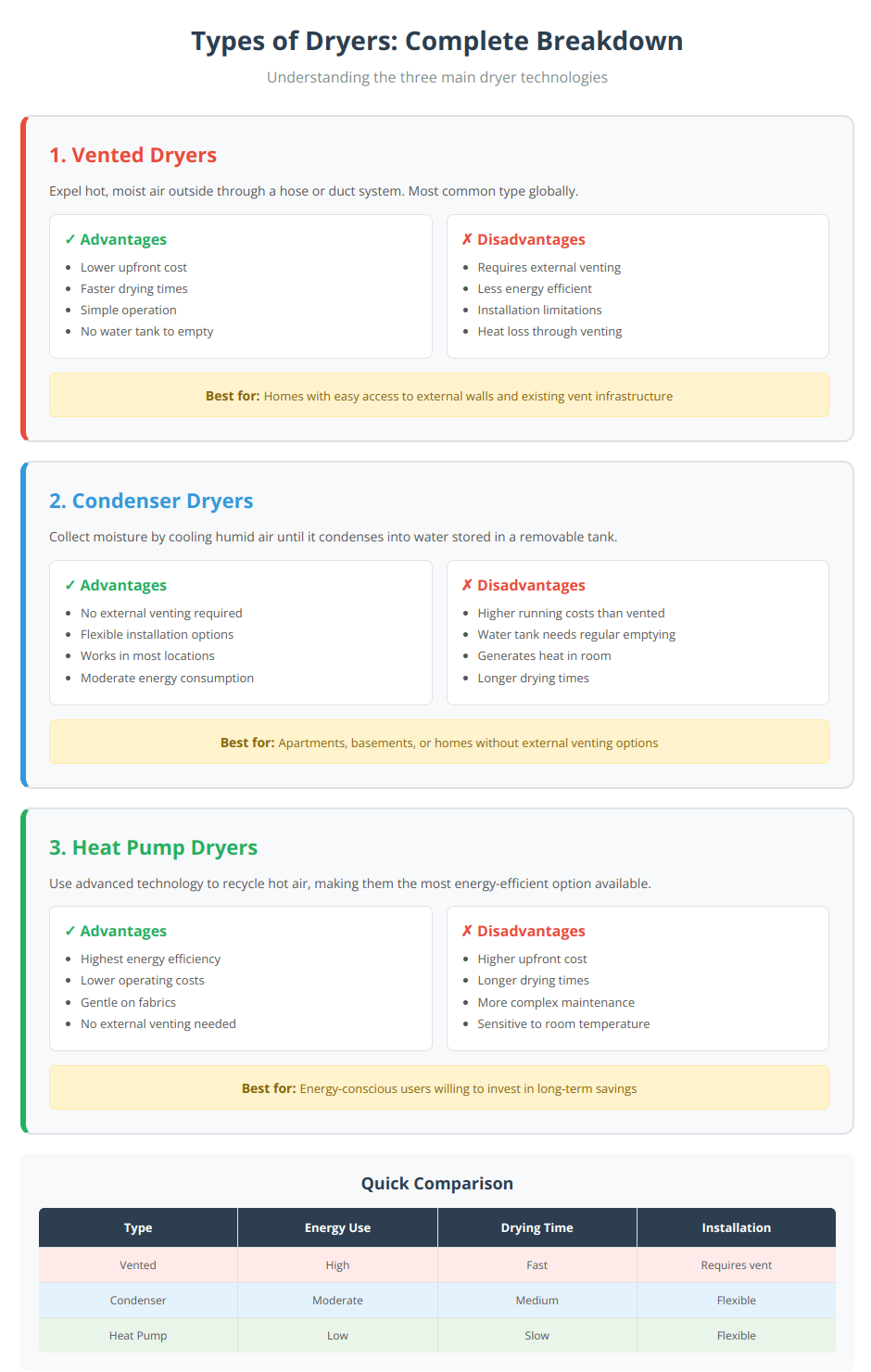
1. Vented Dryers
Vented dryers expel hot, moist air outside through a hose or duct system. They require installation near an external wall or window for proper ventilation.
Advantages:
- Lower upfront cost
- Faster drying times
- Simple operation
- No water tank to empty
Disadvantages:
- Requires external venting
- Less energy efficient
- Installation limitations
- Heat loss through venting
Best for: Homes with easy access to external walls and existing vent infrastructure.
2. Condenser Dryers
Condenser dryers collect moisture from clothes by cooling humid air until it condenses into water. This water is stored in a removable tank that needs regular emptying.
Advantages:
- No external venting required
- Flexible installation options
- Works in most locations
- Moderate energy consumption
Disadvantages:
- Higher running costs than vented dryers
- Water tank requires regular emptying
- Generates heat in the room
- Longer drying times than vented models
Best for: Apartments, basements, or homes without external venting options.
3. Heat Pump Dryers
Heat pump dryers use advanced technology to recycle hot air, making them the most energy-efficient option. They operate at lower temperatures, making them gentler on clothes.
Advantages:
- Highest energy efficiency
- Lower operating costs
- Gentle on fabrics
- No external venting needed
- Reduced environmental impact
Disadvantages:
- Higher upfront cost
- Longer drying times
- More complex maintenance
- Sensitive to room temperature
Best for: Energy-conscious users willing to invest in long-term savings and fabric care.
Energy Efficiency and Environmental Impact
What is the Most Energy Efficient Dryer?
Heat pump dryers are the most energy-efficient option, using up to 60% less energy than conventional dryers. With new EU regulations coming into effect July 1, 2025, only the most efficient heat pump technology will be allowed in European markets.
| Dryer Type | Energy Use | Efficiency Rating | Running Cost |
|---|---|---|---|
| Vented | High | Low | Highest |
| Condenser | Moderate | Medium | Moderate |
| Heat Pump | Low | High | Lowest |
2025 Energy Efficiency Standards
The European Union has implemented new energy labeling requirements that will reshape the dryer market:
- Before July 1, 2025: A+++ to D rating scale
- After July 1, 2025: A to G rating scale with stricter requirements
- Key Impact: Only heat pump dryers will meet the new efficiency standards
This regulatory change is driving manufacturers to focus on heat pump technology, making these models more affordable and widely available.
According to the European Commission, these new regulations will lead to significant environmental and economic benefits by 2040, including cumulative energy savings of 15 TWh and 1.7 million tons of CO2 equivalent reduction. The improved energy efficiency is expected to save consumers approximately €2.8 billion, while supporting the EU’s goal of becoming climate-neutral.
Smart Features and Technology
IoT Integration and Smart Connectivity
Modern dryers increasingly feature smart technology that connects to your home network:
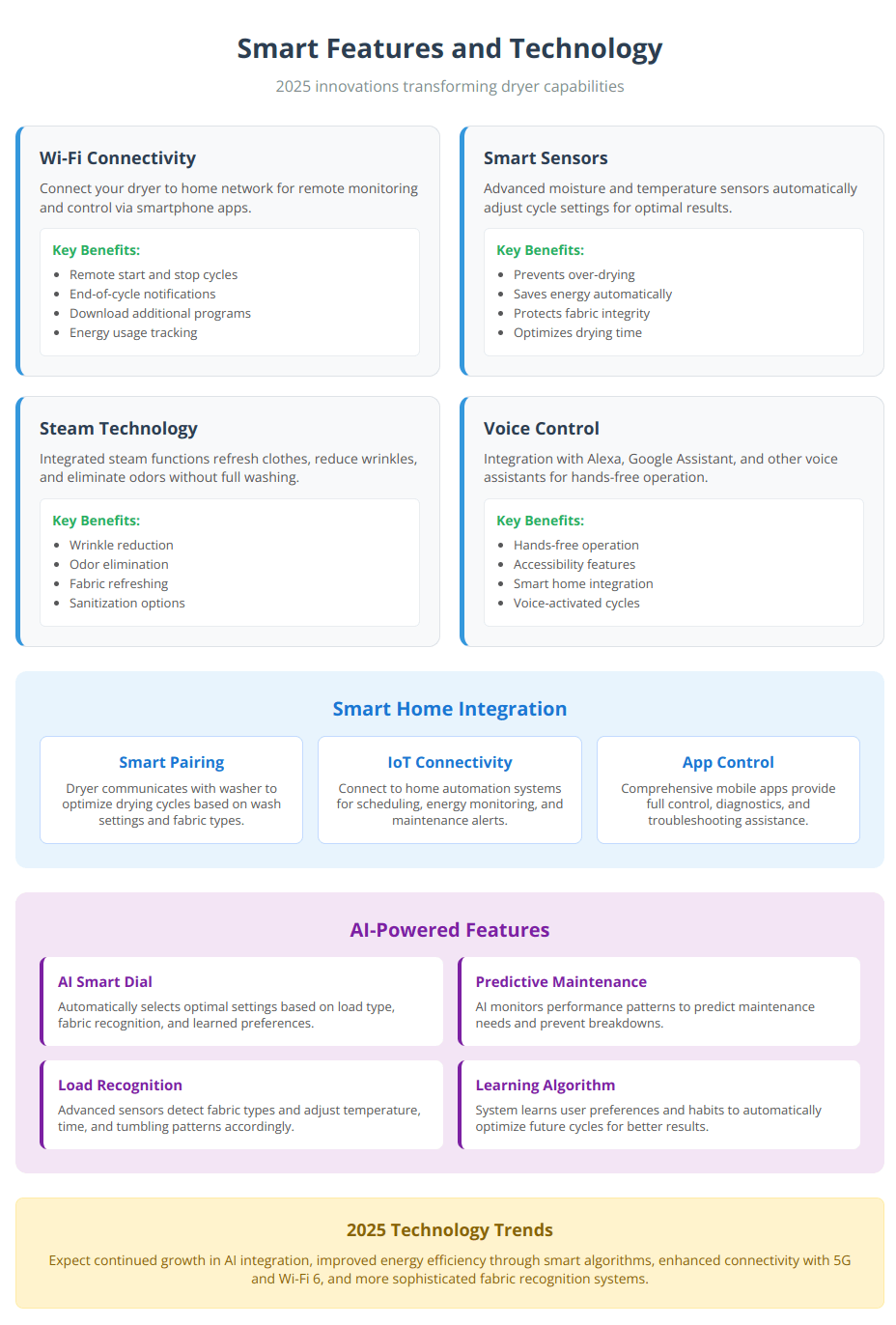
Wi-Fi Connectivity Features:
- Remote start and monitoring via smartphone apps
- End-of-cycle notifications
- Download additional drying programs
- Energy usage tracking
- Troubleshooting assistance
AI Smart Dial Technology:
- Automatically selects optimal settings based on load type
- Learns your preferences over time
- Adjusts temperature and time for different fabrics
- Reduces user error and improves results
Smart Pairing Between Washers and Dryers
Advanced models can communicate with compatible washers to optimize drying cycles:
- IntelligentDry: Dryer receives wash cycle data and recommends optimal drying settings
- Load Recognition: Sensors detect fabric types and moisture levels
- Automatic Adjustments: Cycle time and temperature adjust based on wash program used
Voice Control and Smart Home Integration
Many 2025 models support voice assistants:
- Amazon Alexa compatibility
- Google Assistant integration
- Smart home automation possibilities
- Voice-activated cycle selection
Installation Requirements and Space Planning
Standard Dryer Dimensions
Understanding space requirements is crucial for proper installation:
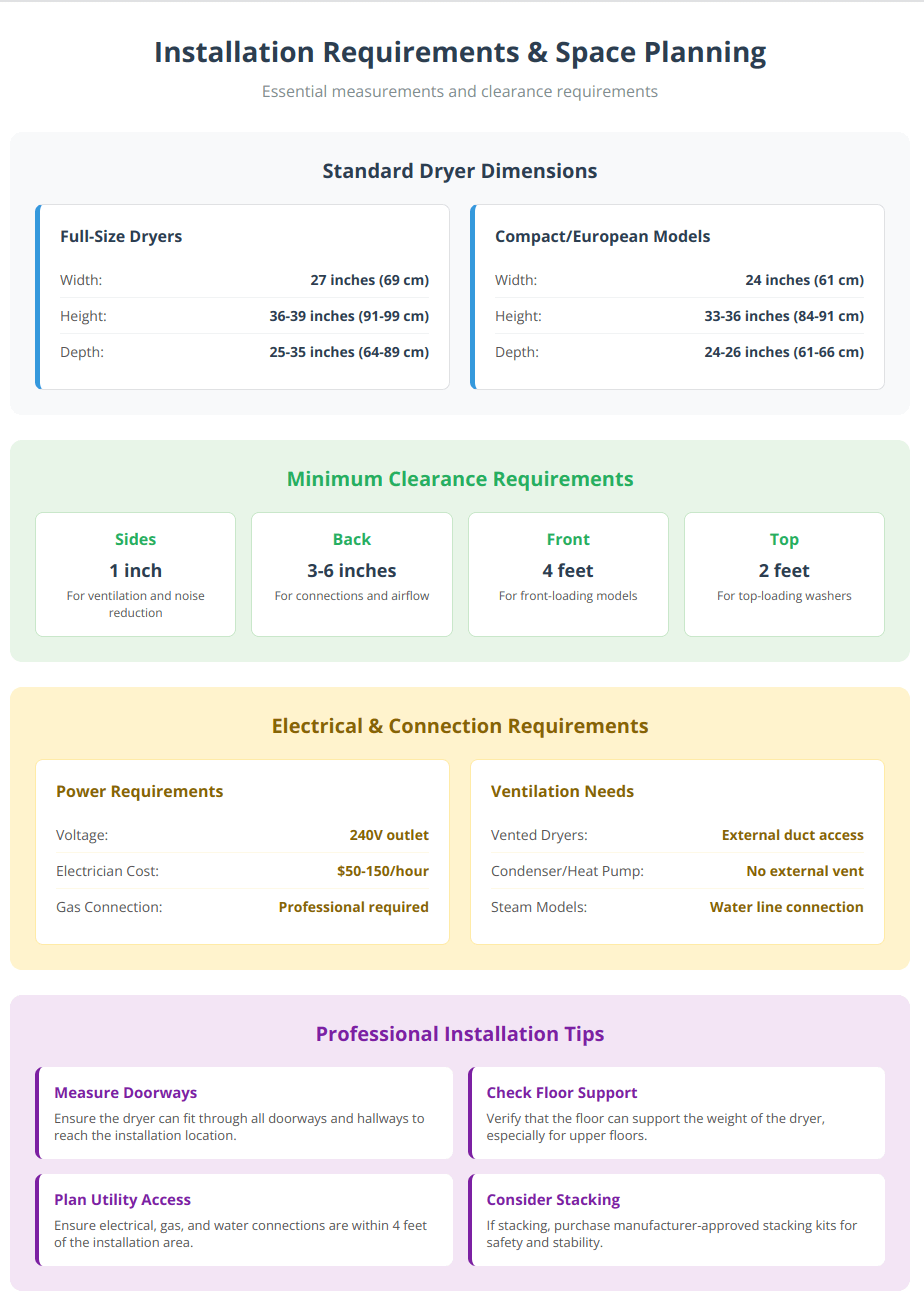
Standard Full-Size Dryers:
- Width: 27 inches (69 cm)
- Height: 36-39 inches (91-99 cm)
- Depth: 25-35 inches (64-89 cm)
Compact/European Models:
- Width: 24 inches (61 cm)
- Height: 33-36 inches (84-91 cm)
- Depth: 24-26 inches (61-66 cm)
Clearance Requirements
Proper clearance ensures safe operation and easy maintenance:
Minimum Clearances:
- Sides: 1 inch (2.5 cm) for ventilation
- Back: 3-6 inches (7.6-15 cm) for connections and airflow
- Front: 4 feet (1.2 meters) for front-loading models
- Top: 2 feet (61 cm) for top-loading washers
Installation Considerations
Electrical Requirements:
- Most dryers require 240V outlets
- Professional installation recommended for safety
- Costs range from $50-150 per hour for electricians
Ventilation Needs:
- Vented dryers need external duct access
- Ductwork should be as short and straight as possible
- Regular cleaning prevents fire hazards
Plumbing Considerations:
- Condenser and heat pump dryers may need drain access
- Water tank models require regular emptying
- Steam-enabled dryers need water line connections
Buying Guide: What to Look For
What Type of Dryer Should I Buy?
Consider these factors when choosing a dryer:
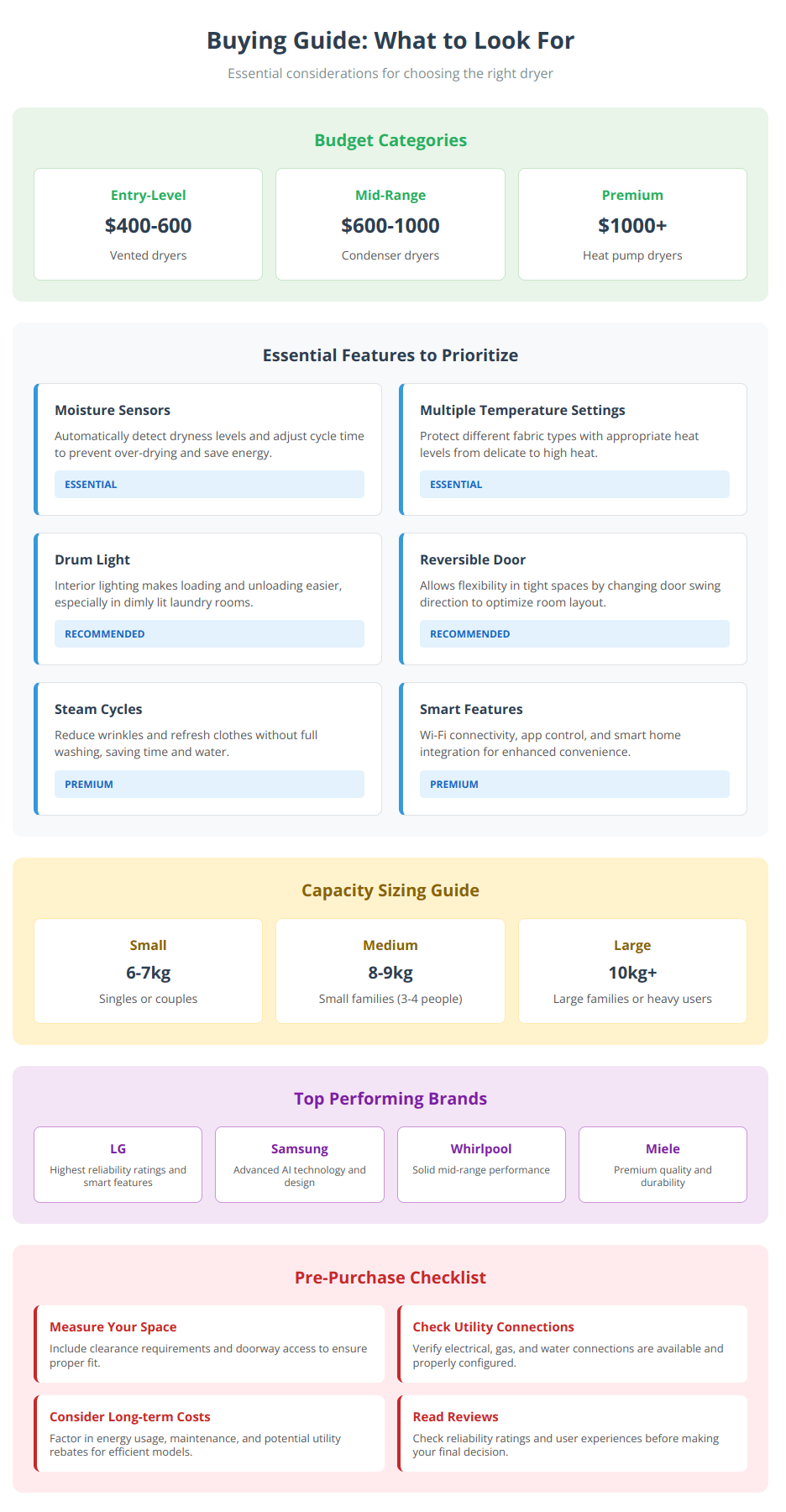
Budget Considerations:
- Entry-level: Vented dryers ($400-600)
- Mid-range: Condenser dryers ($600-1000)
- Premium: Heat pump dryers ($1000-2000+)
Long-term Costs:
- Heat pump dryers offset higher purchase price through energy savings
- Consider utility rates in your area
- Factor in potential rebates for energy-efficient models
What to Look for When Buying a Dryer?
Essential Features:
- Moisture sensors: Prevent over-drying and save energy
- Multiple temperature settings: Protect different fabric types
- Lint filter: Easy access and cleaning
- Drum light: Helpful for loading and unloading
- Reversible door: Flexibility for tight spaces
Advanced Features:
- Steam cycles: Reduce wrinkles and refresh clothes
- Sanitize options: Eliminate bacteria and allergens
- Quick dry programs: Fast cycles for small loads
- Wrinkle prevention: Extended tumbling after cycle ends
Capacity and Sizing
Is an 8kg Dryer Big Enough? An 8kg (18 lb) dryer works well for most households of 3-4 people. Consider your typical load sizes:
- 6-7kg: Singles or couples
- 8-9kg: Small families (3-4 people)
- 10kg+: Large families or heavy users
What Size Dryer for 2 People? A 6-7kg dryer typically meets the needs of two people, allowing for bedding and larger items while maintaining efficiency.
Operating Your Dryer Safely and Effectively
Understanding Dryer Symbols and Settings
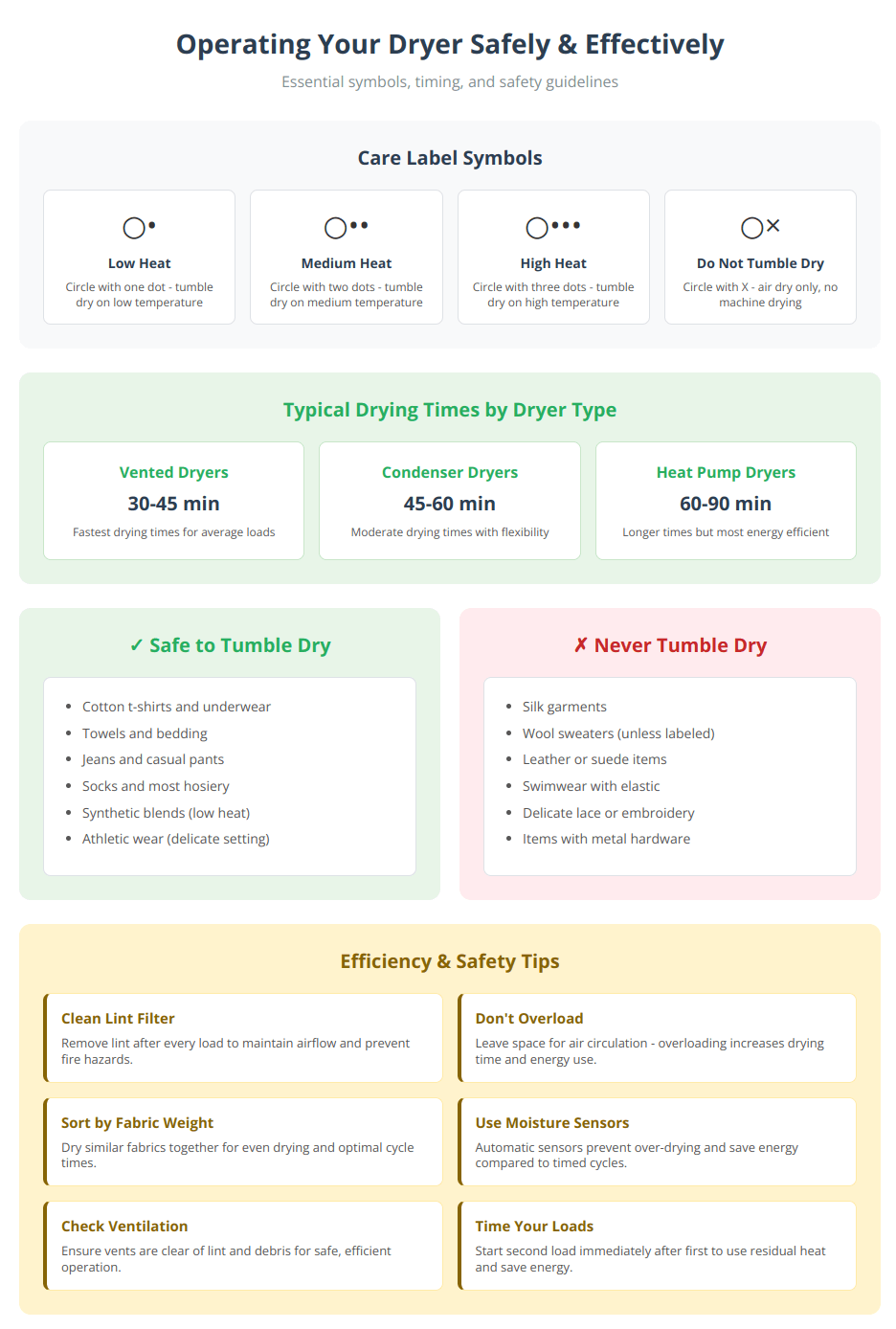
Common Care Label Symbols:
- Circle with dot: Tumble dry low heat
- Circle with two dots: Tumble dry medium heat
- Circle with three dots: Tumble dry high heat
- Circle with X: Do not tumble dry
What Setting is Tumble Dry on a Dryer? Most dryers have dedicated tumble dry settings corresponding to care label symbols. Use the appropriate heat level based on fabric type and care instructions.
Drying Times and Efficiency
How Long to Tumble Dry Clothes? Drying times vary by dryer type and load:
- Vented dryers: 30-45 minutes for average loads
- Condenser dryers: 45-60 minutes
- Heat pump dryers: 60-90 minutes
Factors Affecting Drying Time:
- Load size and fabric type
- Initial moisture content
- Room temperature and humidity
- Dryer maintenance and airflow
What Can and Cannot Be Dried
Safe for Tumble Drying:
- Cotton t-shirts and underwear
- Towels and bedding
- Jeans and casual pants
- Socks and most hosiery
Can You Put Socks in the Dryer? Yes, most socks can be tumble dried. Use medium heat for cotton socks and low heat for synthetic or wool blends.
Can You Put Jeans in the Dryer? Jeans can be tumble dried on medium heat, but air drying helps prevent shrinkage and fading. Turn them inside out to protect the color.
What Not to Put in a Tumble Dryer
Never Tumble Dry:
- Silk garments
- Wool sweaters (unless specifically labeled)
- Leather or suede items
- Swimwear with elastic
- Delicate lace or embroidered items
- Anything with metal hardware that could damage the drum
Why Do So Many Clothes Say Do Not Tumble Dry? Manufacturers use this warning to prevent:
- Heat damage to synthetic fibers
- Shrinkage in natural fibers
- Damage to decorative elements
- Elastic deterioration
- Color fading
For natural vs synthetic fabrics, understanding fiber content helps determine appropriate drying methods.
Troubleshooting Common Issues
Why Does My Tumble Dryer Take 3 Hours?
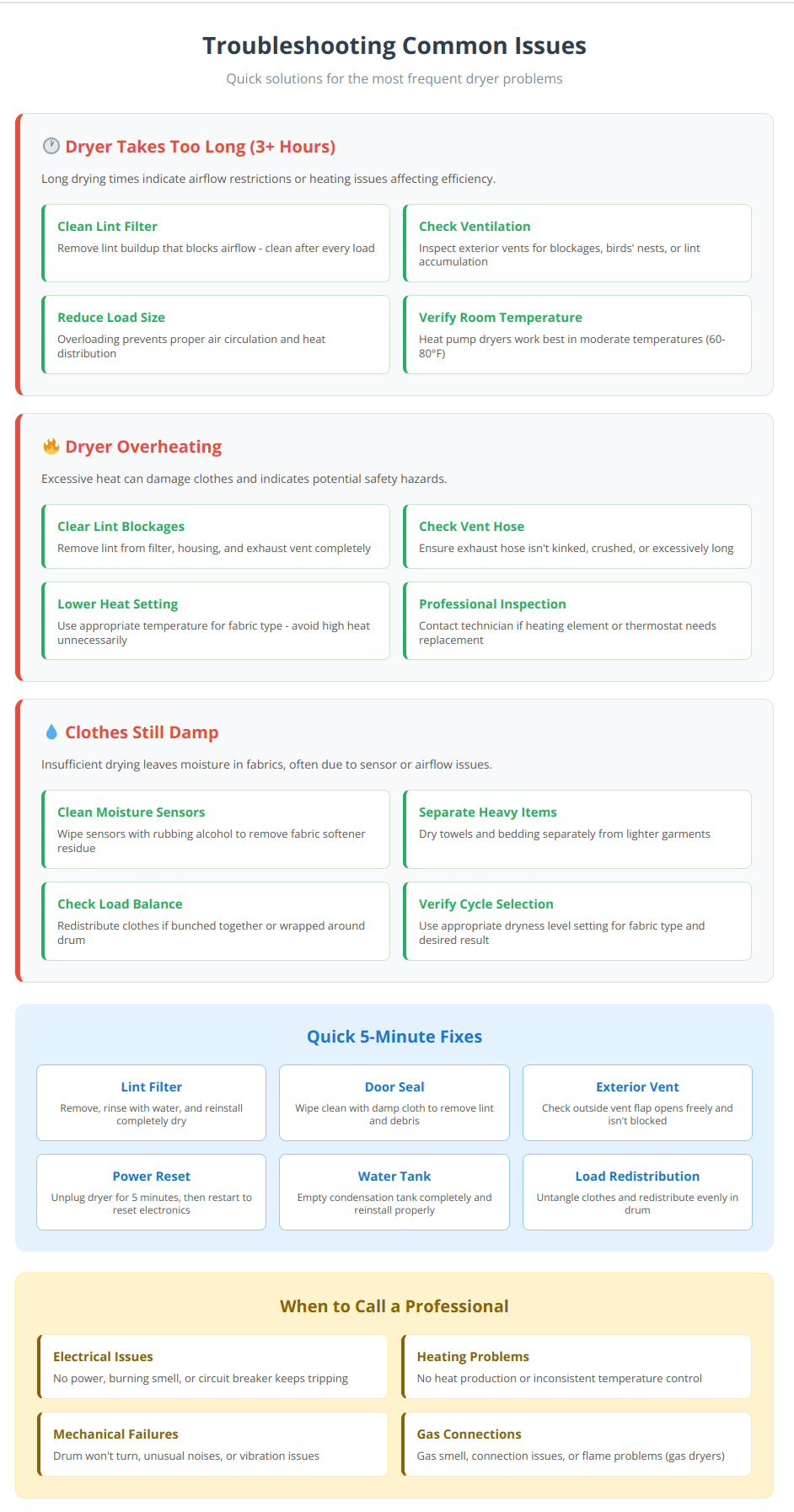
Long drying times typically indicate:
- Clogged lint filter: Clean after every load
- Blocked ventilation: Check exterior vents for obstructions
- Overloading: Reduce load size for better airflow
- Worn heating element: Professional repair may be needed
- Room temperature: Heat pump dryers work best in moderate temperatures
Does Putting a Towel in the Dryer Help?
Adding a clean, dry towel to wet clothes can reduce drying time by absorbing initial moisture. Remove it after 10-15 minutes to prevent over-drying the towel.
How Long Do Towels Take to Dry in a Tumble Dryer?
Towels typically take:
- Single bath towel: 20-30 minutes on high heat
- Load of towels: 45-60 minutes
- Thick or oversized towels: 60-90 minutes
Maintenance and Care
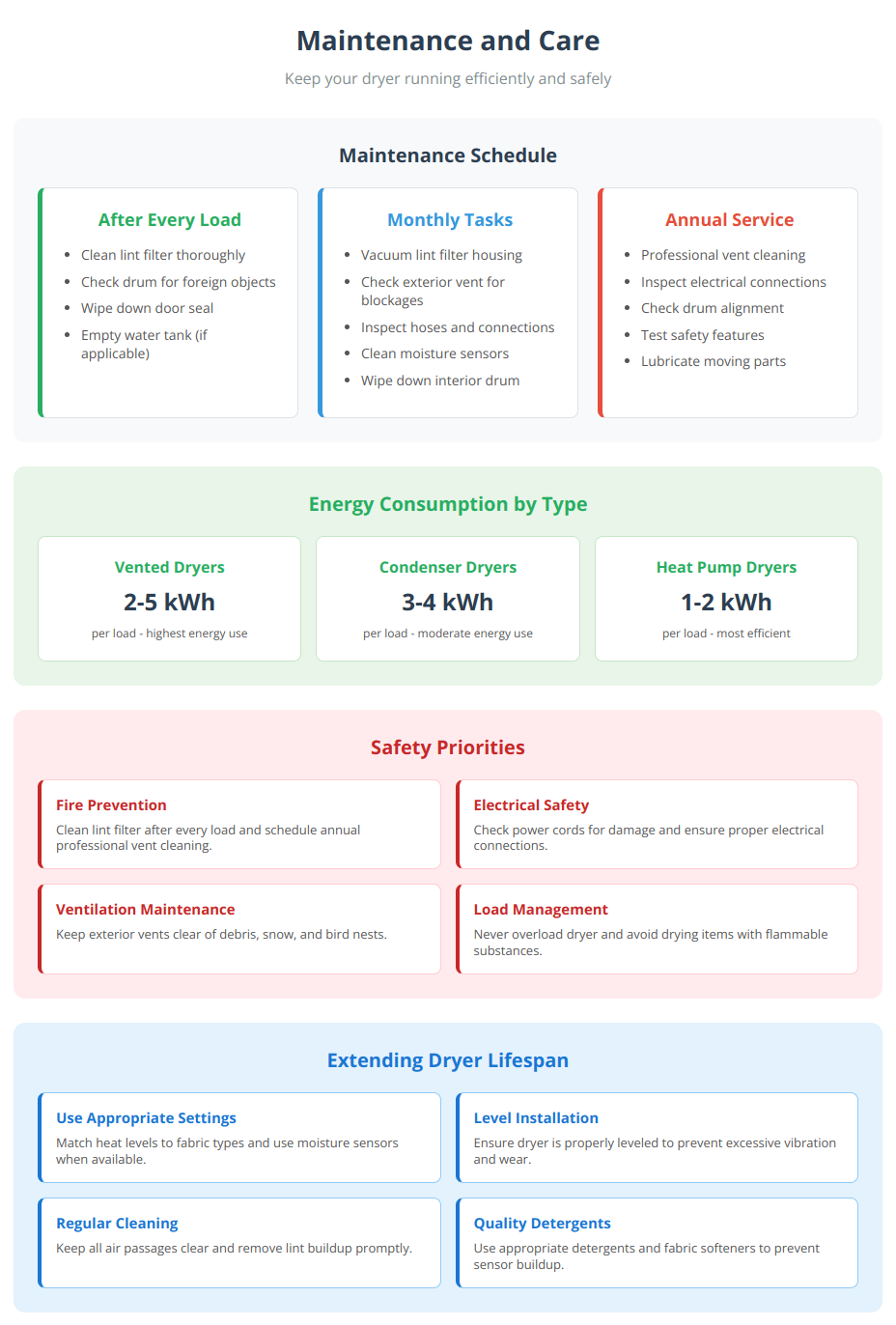
Regular Maintenance Tasks
After Every Load:
- Clean lint filter thoroughly
- Check drum for foreign objects
- Wipe down door seal
Monthly:
- Vacuum lint filter housing
- Check exterior vent for blockages
- Inspect hoses and connections
Annually:
- Professional vent cleaning
- Inspect electrical connections
- Check drum alignment
Does a Tumble Dryer Use a Lot of Electricity?
Energy consumption varies by type:
- Vented dryers: 2-5 kWh per load
- Condenser dryers: 3-4 kWh per load
- Heat pump dryers: 1-2 kWh per load
With electricity costs around $0.12-0.20 per kWh, heat pump dryers can save $50-100 annually compared to conventional models.
Making the Right Choice for Your Home
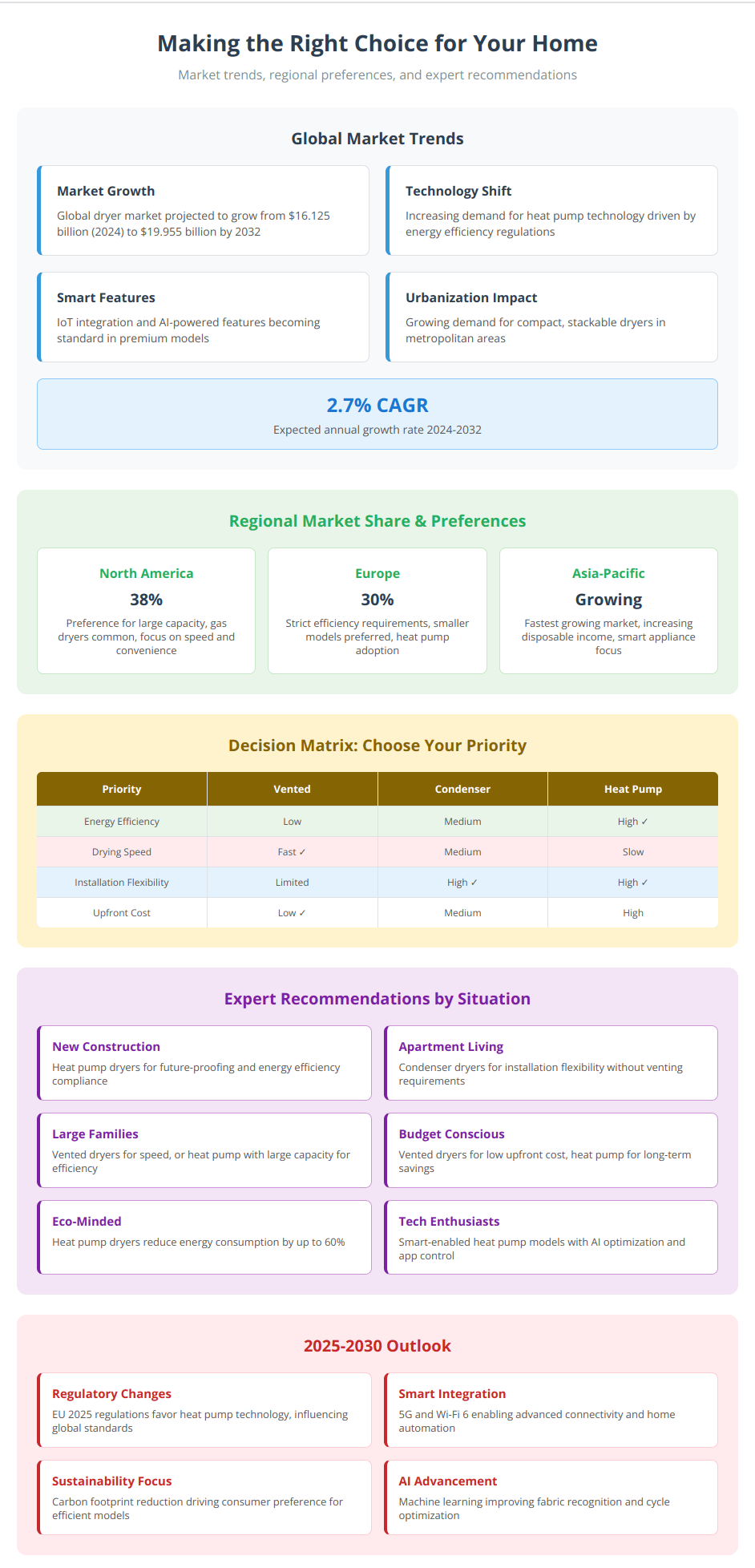
Market Trends and Future Outlook
The global tumble dryer market is projected to grow from $16.125 billion in 2024 to $19.955 billion by 2032, driven by:
- Increasing urbanization
- Rising energy consciousness
- Smart home integration
- Regulatory efficiency requirements
Regional Considerations
North America (38% market share):
- Preference for large capacity models
- Gas dryers more common
- Focus on speed and convenience
Europe (30% market share):
- Stricter energy efficiency requirements
- Smaller, more efficient models
- Heat pump technology adoption
Asia-Pacific (fastest growing):
- Increasing disposable income
- Urban living space constraints
- Smart appliance adoption
Brand Reliability and Performance
Based on consumer testing and reliability data:
Top Performing Brands:
- LG: Highest reliability ratings and smart features
- Samsung: Advanced AI technology and design
- Whirlpool: Solid mid-range performance
- Miele: Premium quality and durability
Consumer Reports conducts rigorous testing on clothes dryers using standardized protocols that evaluate drying performance, dryness sensitivity, capacity, and noise levels. Their testing methodology includes running loads of varying weights and fabric mixes to determine real-world performance, providing consumers with objective data on which brands and models perform best over time.
Frequently Asked Questions
How Do I Tell Which Dryer I Have?
Check the model number on the manufacturer’s label (usually inside the door or on the back). This will tell you:
• Dryer type (vented, condenser, or heat pump)
• Capacity and energy rating
• Manufacturing date and specifications
Are All Dryers the Same?
No, dryers vary significantly in:
• Drying technology (vented, condenser, heat pump)
• Energy efficiency ratings
• Capacity and dimensions
• Features and smart capabilities
• Price and operating costs
What is the Most Common Type of Dryer?
Vented dryers remain the most common type globally, though heat pump dryers are gaining market share rapidly due to efficiency regulations and environmental concerns.
Do All Dryers Need to Be Vented Outside?
No, only vented dryers require external ventilation. Condenser and heat pump dryers can be installed anywhere with adequate space and power supply.
Where Not to Put a Tumble Dryer?
Avoid placing dryers in:
• Unventilated closets (without proper airflow)
• Extremely cold or hot environments
• Areas with high humidity
• Near water sources (for safety)
• Spaces without adequate electrical supply
When Should You Not Use a Tumble Dryer?
Consider alternatives when:
• Care labels prohibit tumble drying
• Energy costs are particularly high
• Delicate items need special care
• Weather permits effective air drying
• Trying to minimize environmental impact
Understanding how to wash and care for different fabrics helps determine the best drying method for each item.
How Old is My Tumble Dryer in the UK?
Check the serial number or model number on the manufacturer’s label. Many UK manufacturers use date codes in their serial numbers, or you can contact the manufacturer’s customer service with your model details.
Conclusion
Understanding the differences between dryer types, their features, and proper usage helps you make an informed decision that fits your lifestyle and budget. While “dryer” and “tumble dryer” generally refer to the same appliance, regional terminology and specific features can vary significantly.
Key Recommendations
- For Energy Efficiency: Choose heat pump dryers for the lowest operating costs and environmental impact, especially with new EU regulations favoring efficient models.
- For Quick Results: Vented dryers offer the fastest drying times if you have proper ventilation access.
- For Flexibility: Condenser dryers provide installation versatility without requiring external venting.
- For Smart Features: Look for Wi-Fi connectivity, AI optimization, and smart pairing capabilities in 2025 models.
- For Long-term Value: Consider total cost of ownership, including energy usage, maintenance, and potential rebates.
Installation Planning
- Measure your space carefully, including clearance requirements
- Consider professional installation for safety and warranty compliance
- Factor in utility connections and ventilation needs
Maintenance Priorities
- Clean lint filters after every load
- Schedule annual professional vent cleaning
- Monitor energy usage and drying times for signs of issues
Future-Proofing Your Purchase
- Smart connectivity features add convenience and monitoring capabilities
- Energy-efficient models provide long-term savings and environmental benefits
- Consider capacity needs for your household size and lifestyle
The dryer market continues evolving with smarter technology, better energy efficiency, and improved user experiences. Whether you call it a dryer or tumble dryer, choosing the right model with proper installation and maintenance will provide years of reliable service while caring for your clothes and managing energy costs effectively.
By understanding these fundamentals and staying informed about new technologies and regulations, you can make a confident decision that meets your needs and supports your household’s laundry routine for years to come.

